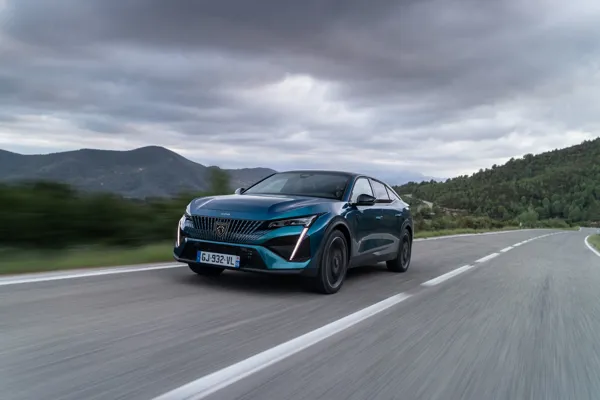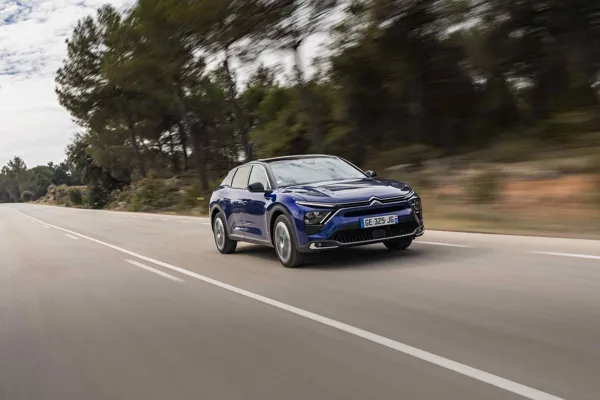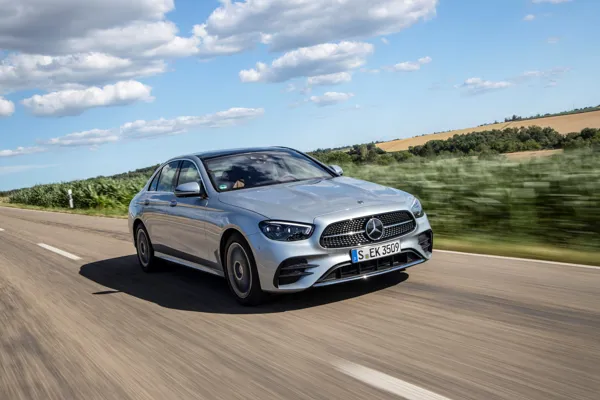Review
The Superb, while not spending as much time running on electric as I’d hoped due to a lack of charging capability at home, impressed with its overall frugality, commonly returned petrol-only consumption figures of 45-48mpg. Following the occasional trip to the office, a freshly charged Superb showed itself equally capable when running in electric mode.
One 17-mile journey on electric-only driving with a starting range of 26 miles gave me a bonus gift of four miles (it used up only 13 miles). With a stated range of 34 miles, the Superb would comfortably accommodate a round trip commute on electric, potentially saving me £20 a week (more than £1,000 a year) under our pre-Covid working practices.
Our seven-month test hasn’t gone entirely smoothly. We switched into a replacement model while our car returned to Skoda for a fix to the charging locking mechanism, while barely a journey goes by without the Superb demanding a software update (something which oddly can only happen when the car is stationary). We also had a pointless trip to pump up the tyres after a phantom alert by the pressure monitoring system.
However, niggles aside, the Superb remains an excellent family car. Spacious for occupants and their luggage (thanks to the battery packed being tucked away in the chassis floor), smooth and controlled to drive, effortless on long journeys (when those finally return), and packed with useful technology and safety aids as standard, it ticks many boxes in a competitive market segment.
Overall, then, the Skoda Superb iV is well worth considering as a first step into the world of electric driving.
Battery can deliver more EV miles than figures suggest
We have returned to our original Superb long-term test car after it spent a couple of weeks with Skoda for a repair to the charging system (see below).
The mechanism on the car into which the charging cable fitted wasn’t locking correctly, so it has been replaced. As an extra measure “to be sure the charger is working fully at its best”, Skoda also advises to lock the car when charging, so it fixes the charger in place.
A rare trip to the office gave me the chance to check this out – everything is working normally. I was able to get 26 miles of charge into the Superb (around 76% of the 34-mile maximum fill) from empty over the course of just less than four hours from our 22kW charge point, sufficient to test the range capacity on my journey home.
Slotting the car into E-mode to prioritise electric-only driving, I managed the 17-mile trip home on silent running and reversed onto my drive with 13 miles left – four more than the original range suggested.
Impressive, and suggests that, by exploiting the regenerative braking and judicious use of the accelerator, the plug-in hybrid system is good for more mileage than stated by the official figures.
One criticism is that the Type 2 charger on the Superb only charges at 3.6kW, which means regardless of the power output of the charging point, whether fast (typically 7W and 22kW), rapid (50kW-plus) or ultra-rapid (above 100kW), it will only fill at the same 3.6kW rate.
Skoda claims 3.5 hours empty-to-full, although our experience would add up to an hour to that. It’s something we’ll check the next time we visit the office.
Gripes not present on replacement car
We’re in a new Superb! Ours has developed a fault with the charging system: in short, it won’t charge, so Skoda has whisked it away and given us a temporary replacement.
On paper, it’s near identical in all but trim, wheel size and colour – this model is the Sportline Plus in Meteor Grey with 19-inch Vega alloys listed at £40,430 compared with our original Superb’s £36,685.
While disappointed that our reigning Fleet News Awards upper-medium car of the year (five times in a row, no less) has proven fallible, it has provided a perfect opportunity to test some of our gripes on a different model.

So, what have we learned about Superb No2? I was eager to test reverse gear: Superb No1 had a mini seizure every time reverse was selected, taking sometimes a full two seconds to engage, leaving both car and me stranded in the road.
However, no such problem for Superb No2: it instantly engages for a seamless reversing manoeuvre.
Another plus: No1 repeatedly tossed software update requests at me; No2 seems not to require such regular fixes.
Further likes are the colour, alloys and Alcantara sports seats, but it isn’t all lavish praise for the newcomer.
Superb No2 has a wider 9.2-inch touchscreen display which is noticeably less functional that No1’s eight-incher, primarily because you lose the quick access keys in order to accommodate the bigger screen. In this case, smaller is better; the quick access keys make navigating the system far simpler.
Our time with No2 was short-lived; after two weeks at Skoda HQ, No1 was back in our possession.
Practical, despite fitment of large battery
Despite lugging around a13kWh Li-ion battery, the Superb iV is a highly practical family car.
The battery is tucked away in the chassis floor under the rear seats. Meanwhile, the two charging leads, one fast, one three-pin, are stored in a convenient compartment below the boot lining.
Consequently, the iV offers impressive luggage capacity of 485/1,610 litres (seats up/down) - admittedly noticeably less than the cavernous 625/1,760 in the petrol/diesel models, but not much smaller than the likes of the Ford Mondeo (541 litres), Peugeot 508 (487 litres) and Vauxhall Insignia (490 litres).
The electric apparatus, including the 135kg battery, electric motor and leads, increase the weight of the Superb from 1,360kg for the 1.4 petrol to 1,730kg. You might expect a major hit to the fuel efficiency running the PHEV solely on petrol, but you’d be wrong. We’re averaging 48mpg compared to the official combined 54mpg for the lighter 1.4 petrol.
Inside, you couldn’t ask (or want) for more space. Head, arm and leg are proffered ample, best-in-class space, with five adults easily accommodated.
Yet the internal dimensions do not come at the expense of over-sized external proportions. The Superb is actually 2mm shorter than the Mondeo (at 4,869mm) with a 9mm shorter wheelbase, although it is 12mm wider (at 1,864mm).
With the support of front and rear sensors, parking is painless although the rear sensors could be a little more progressive, going from a relaxed beep to a panic stricken “argh stop!” in a matter of inches. The emergency brakes have intervened a couple of times to save the rear bumper from some dangerous leaves that were lurking in the shadows (nothing more serious, though).
The SE L trim is packed with standard equipment – the only option on our test car is metallic paint, at £595. Particular likes include the driver fatigue sensor (not personally required, but a good safety addition), electrically operated boot (note to Skoda: the beeping warning that accompanies remote operation is a little embarrassing in public) and straightforward wireless connection to Apple CarPlay.
And, it never gets old to receive a Skoda with ice scraper in the fuel filler cap, removable LED lamp in the boot and umbrellas stored in the driver and front passenger doors.
Frugal, even without charge
Skoda, you owe me 50p. Readers may recall that the tyre pressure monitoring system alerted me to low pressure in two tyres recently.
Each should be 36PSI. Clockwise, from rear nearside, they were 36/35/36/36! Hardly cause for the warning light to come on, surely. The 50p? That’s how much it cost to check the pressures.
The system has now been re-set, so, hopefully, it will settle down for the rest of our time with the car.
Being primarily home-based for work, and without access to a fast charger, the plug-in hybrid Superb is spending very little time running on electric. However, the 1.4-litre petrol engine is surprisingly frugal.
On steady journeys, it is comfortably averaging 48mpg. The WLTP figure is 148.7-217.3mpg, but the comparison is unfair without regular charging.
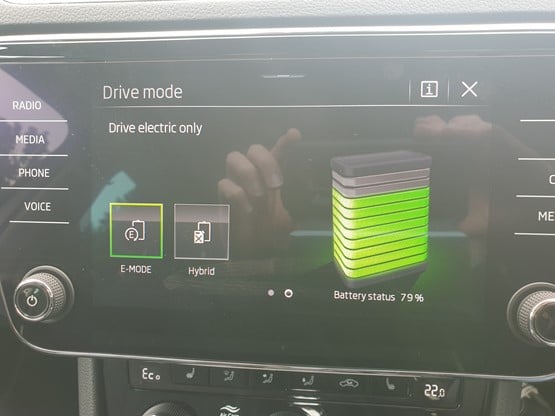
The 1.5-litre TSI DSG petrol Superb, meanwhile, returns just 43.5mpg and has a 68PS power deficit. Given the extra battery weight carried around by the PHEV, 48mpg is a decent return.
Of course, if I was working in – and charging up at - the Fleet News office, the electric range of 34 miles would see me home and back again, enabling me to run 100% on electric.
That’s where the case for plug-in hybrids is really made. My pre-coronavirus weekly routine was typically three days in the office, two out at meetings – often round trips of 300 miles or more.
The petrol range, which exceeds 450 miles with careful driving, accommodates these longer trips in a way pure electric vehicles currently cannot. At least, not without a mid-journey charge-up, and that’s not always possible due to the infrastructure or time.
My driving behaviour hasn’t quite made the cultural leap to pre-planning journey times and routes with charging breaks included.
PHEV, therefore, works well (assuming access to the office chargers). And, with BIK of just 10%, the monthly tax bill of £60 for a 20% taxpayer or £120 for a 40% earner only adds to the Superb’s appeal as a company car.
Software glitches require updates
The Superb has bugs. Not the creepy-crawly type, but minor software glitches that need over-the-air updates. The issue is, those updates can only take place when the car is stationary, and they aren’t quick, so rather than sit on the driveway with the engine running, I’ve been cancelling them.
Don’t worry, Skoda, I will find the time to baby-sit the car soon to allow the updates to complete.
There are a couple of other annoyances that have come to light now I’m more mobile post-lockdown.
The automatic six-speed gearbox is refined, with effortless changes and a rapid reaction when stepping on the accelerator to overtake. However, selecting reverse is another matter; then, the gearbox can take a second or so to engage, leaving the car temporarily stranded.

We’ve encountered this on previous test cars, and it becomes frustrating if, like me, you always reverse park.
Remote locking of the car is also a little hit-and-miss – the key needs to be pointed at a particular spot because often I wave it in the general direction of the car, press lock and nothing happens. I would prefer it to be a bit more sensitive.
Talking of sensitivity, what could’ve been a gripe should really be praised as a valuable safety aid – the tyre pressure monitoring system (TPMS).
As I write, the tyre pressure warning light has lit after just 1,500 miles, or two months since we took delivery. Unchecked tyres can lose 1-2 PSI a month, so it’s a timely reminder to frequently check tyres, even when mileages are low.
However, the TPMS generally comes on when the tyre pressure falls below 75% of the recommended value, which, in the Superb’s case would be 27 PSI (recommended 36).
My experiences with other test cars suggest that most systems are much more sensitive than this – but that’s no bad thing if it encourages more regular safety checks.
And, of course, checking the tyre pressures will give me the stationary time for the software updates to finish!
Skoda Superb iV SE-L plug-in hybrid joins our fleet
When we first drove the Skoda Superb iV plug-in hybrid at the tail end of 2019, we described it as an “attractive” proposition for company car drivers.
With benefit-in-kind taxation (BIK) from just £60 per month for a 20% taxpayer, or £721 a year, on a £36,000 car, attractive is arguably a huge undersell.
Remember, the Superb is a five-time winner at the Fleet News Awards: you simply cannot get a better upper-medium car. And the PHEV model saves a company car driver £1,300 a year in BIK compared with the 2.0-litre diesel, despite carrying a £5,500 price premium.
The good news continues for fleet operators: at 36.47ppm, running costs are 4ppm cheaper, resulting in a saving of almost £3,500 over four years/80,000 miles – although these figures are based on full-time electric running, which is a little unreasonable, despite the Superb’s impressive 34-mile range.

Using fuel cost at 50% of diesel, rather than 0%, as a comparison may wipe out the overall running cost saving, but still leaves the PHEV in an advantageous total cost of ownership position when national insurance and corporation tax savings are added to the mix.
Our test car is the SE L hatch, which comes loaded with equipment. The only option is metallic paint at £595, taking the price to £36,685.
Standard fit includes adaptive cruise control, sat-nav with eight-inch touchscreen, blind spot detection, driver fatigue sensor, dynamic chassis control, electrically-operated boot, multi-collision braking, front/rear sensors, voice control and wireless Apple CarPlay amid an extensive list. We’ll delve into more detail in future reviews.
The Superb is powered by a 1.4-litre TSI 156PS petrol with an 85kW/115PS electric motor for total power of 218PS. Combined fuel efficiency is 148.7 to 217.3mpg, while CO2 emissions are just 30g/km.
The battery does eat into the boot space, reducing capacity from 625 litres to 485. Nevertheless, that’s still competitive.
Specs
| Manufacturer | Skoda |
| Model | Superb |
| Specification | Superb Hatch 5Dr 1.4TSI iV PiH 13kWh 218 GPF SS €6 SE L DSG Auto6 21.25MY |
| Model Year | 0.00 |
| Annual VED (Road tax) | £0 |
| BIK List Price | £37,020 |
| CO2 | 25g/km |
| BIK Percentage | 11% |
| Insurance Group | N/A |
| CC | N/A |
| Fuel Type | Petrol Hybrid |
| Vehicle Type | Large family car |
| Luggage capacity (Seats up) | 5litres |
Running Costs
| P11D | £37,020 |
| Insurance group | N/A |
| Fuel Type | Petrol Hybrid |
| Cost per mile | 94.26ppm |
| Fuel | 7.35ppm |
| Depreciation | 84.68ppm |
| Service maintenance and repair | 2.23ppm |
Rivals
Info at a glance
-
P11D Price
£37,020
-
MPG
256.8 (WLTP) -
CO2 Emissions
25g/km -
BIK %
11% -
Running cost
3 Year 60k : N/A 4 Year 80k : N/A -
Fuel Type
Petrol Hybrid



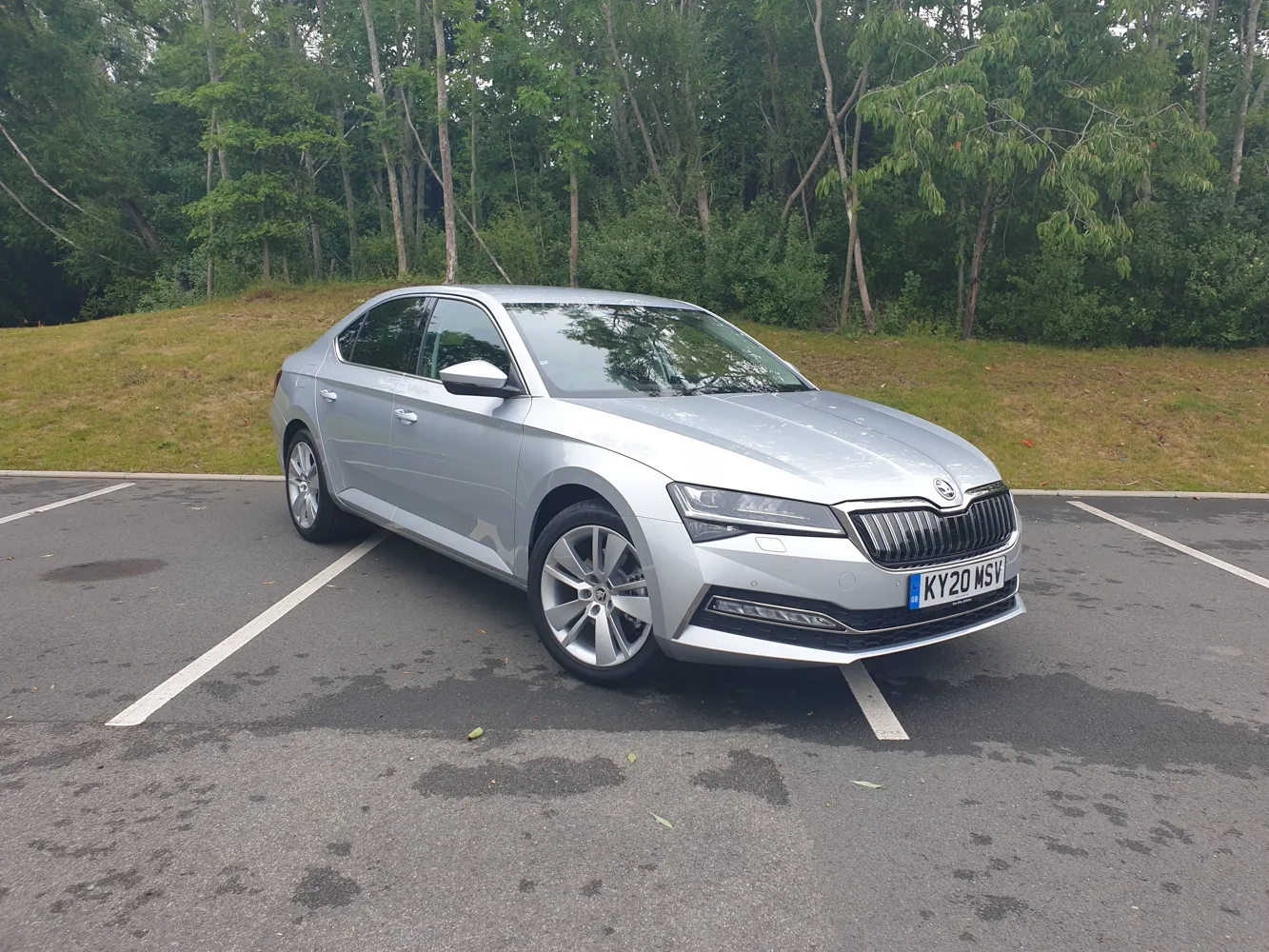










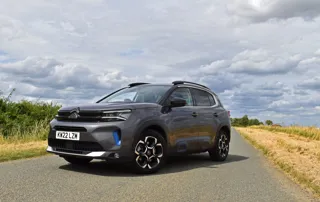
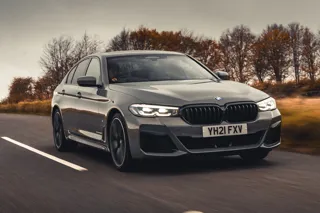

 Petrol Hybrid
Petrol Hybrid

